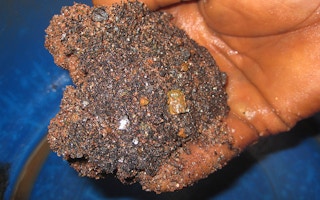Strong evidence links the mining of minerals to local conflict in several African countries. This is because minerals are prized by rebel groups and are a source of their financing. Examples include the “blood diamonds” that were used to finance armed groups in Sierra Leone and Liberia.
But existing research makes no distinction on how the two main types of mineral extraction—artisanal and industrial mining—affect conflict. Making this distinction is important. Doing so means policymakers can direct interventions towards reducing conflict.
Artisanal mining generally refers to the manual extraction of minerals. It’s often controlled by local elites. It provides working opportunities for up to 20 million people in Africa alone. Industrial mining is mechanised; practised by large, often international, companies. It has close relations with national elites but only provides a few jobs to low-skilled workers.
In our recent study, we looked at how two events—changes in world prices of minerals and a surge in industrial mining—affected local conflict in eastern Congo between 2004 and 2015. We found that artisanal and industrial mining had different impacts.
In the case of artisanal mines, when mineral prices rose there were more battles between armed groups over the mines. By contrast, when industrial mining was established there were fewer. But we also saw that the expansion of industrial mines triggered riots and also increased violence against civilians.
Our findings highlight a need for more security measures at artisanal mining sites. They should be secured, as the industrial sites are, with the help of the Congolese mining police and army to ensure less violence.
“
Artisal mining provides working opportunities for up to 20 million people in Africa alone.
Linking extraction modes to local conflict
We focused on eastern Congo because it has high rebel activity, high levels of conflict and is well-known for its mineral deposits, mainly gold and the ‘3T minerals’—tin, tungsten, and tantalum. These three are commonly found in electronics products. It also has a huge database on artisanal mining sites and their locations.
Currently, about 382 000 artisanal miners dig for minerals in eastern Congo’s 2,700 mining sites. Because there are so many, the central government struggles to get a grip on them. The minerals they dig up are easily smuggled out of the country, escaping formal taxation. Artisanal mining should take place in clearly demarcated zones.
But very few of these exist and only 1 per cent of artisanal miners operate in them. The majority (61 per cent) operate on industrial concessions.
To study the link between the mode of mineral extraction and local conflict, we overlay the map of eastern Congo with 2,176 grid cells of 25 by 25 km. For each cell we established whether artisanal and/or industrial mining was present. In total we examined data on 2,026 artisanal mining sites, 3,695 large-scale mining concessions and 6,542 conflict events that occurred between 2004 and 2015.
We explored how variations in conflict events—like battles between armed actors, violence against civilians, riots and looting—related to changes in the Congolese mining sector. Specifically, variations in world mineral prices and a surge in the granting of industrial mining concessions.
There are other factors that affect violence. But we isolated the impact of prices by studying monthly changes in violence and controlled for all common changes across grid cells—like elections—and for all fixed factors within each cell—like geography.
As for the relationship with rising industrial mines, a change in the mining code in 2002 triggered a huge rise in industrial permits—from 237 to 3,368 research permits and 82 to 327 production permits. This allowed us to investigate the sector’s relationship to conflict.
Different forms of violence
We found that both extraction modes, and how they interacted with each other, led to different forms of violence.
A rise in global mineral prices led to increased battles, attacks against civilians and looting around artisanal mining sites. We believe this was because of competition between armed groups. Armed actors—like rebels or government soldiers—were present in about 56 per cent of artisanal mining sites.
In contrast, at industrial sites, changes in mineral prices had little to no effect on conflict. Our interpretation is that companies can protect their concession against armed groups with the help of private security forces and the Congolese Mining Police and Congolese Army. This also decreased battles between armed actors.
However, a move to the industrial production phase increased incidences of violent actions from miners against the company.
Industrial companies try to address artisanal miners, who often operate on their concessions, with carrots – like corporate social responsibility programs—and sticks, such as forced removal. But the carrots aren’t enough to accommodate the vast number of miners and the sticks often backfire.
Moreover, where industrial production activities expand into areas used by artisanal miners, we found an increase in attacks against civilians and looting. We are currently doing research on this. We believe it’s because armed actors and/or miners who previously profited from artisanal mining try to find other sources of income, such as theft or by levying taxes at roadblocks.
Policy implications
Governments and policy-prescribers—like the International Monetary Fund and World Bank, which inform the design of mining policies—tend to favour industrial mining over artisanal mining because of its superior revenue-generating potential for the government.
While the relation between mineral price increases and local conflict at artisanal sites, and its relative absence at industrial sites, may add to the arguments of those who seek to replace artisanal by industrial mining, there are other important considerations.
First, a major difference between artisanal and industrial sites is that mining companies, being backed by the government and national army, are able to secure their concessions. But this is a political choice: there is nothing inherent about artisanal sites that prevents the same type of security.
The Ministry of Mines should revise the mining code to formalise and accommodate artisanal mining. It should also employ the army to secure artisanal sites. But first the army must be “sanitised”; it’s currently corrupt and is itself involved in illegal taxing and trafficking of minerals mined by artisans.
Second, any policy to expand industrial mining should incorporate measures that protect local mining communities and mitigate unintended economic and social effects, including the effect on the behaviour of armed actors.
This article was originally published on The Conversation.













